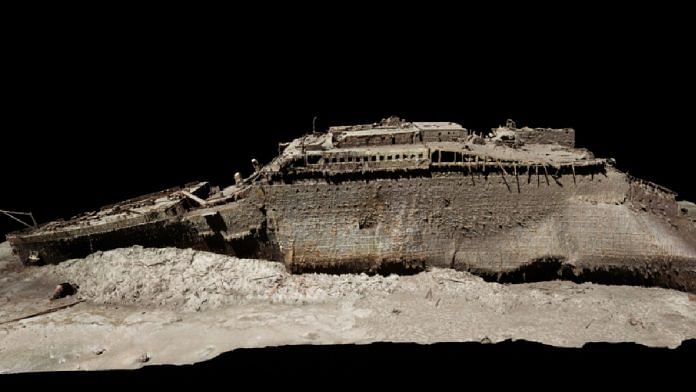New Delhi: Relying on 700,000 photographs of the wreck — taken by two submersibles named ‘Romeo’ and ‘Juliet’ — and cutting-edge technology, researchers have created the first full-sized 3D scan of the Titanic, which will allow the world to visualise the ocean liner in its entirety if all the water surrounding it were drained away.
This is being seen as the first step towards evidence-based research, rather than speculation, on the tragedy that killed an estimated 1,500 people on 14 April, 1912, when the British luxury ocean liner collided with an iceberg on its maiden voyage from Southampton, England to New York City, USA. The Titanic has been resting at the bottom of the North Atlantic Ocean since.
The rusted wreckage lies 3,800 m (12,500ft) beneath the Atlantic Ocean’s surface, 400 miles from south of Newfoundland, Canada. Its 3D scan has been created using deep-sea mapping techniques.
The scan was carried out by Magellan Ltd — a deep-sea mapping company — as well as Atlantic Productions, who are also making a documentary on the project.
The “digital twin” has been created from every angle and using 16 TB of data by a team of researchers who are experts in geotechnical surveys and deep water exploration.
Magellan’s founder, Richard Parkinson said the data is “approximately ten times larger than any underwater 3D model that’s ever been attempted before,” according to a report in The Telegraph.
Using this photorealistic 3D model, one is able to witness the entire shipwreck at once unlike the 1986 footage wherein one could only look at one small area at a time.
Also Read: New 3D map shows Milky Way isn’t shaped like pancake but a warped wave
The scan, the detailing
According to media reports, during a six-week expedition to the North Atlantic wreck site in 2022, two submersibles — Romeo and Juliet — were remotely controlled by a team that was onboard a specialist ship. It took over 200 hours to survey the wreckage and create the entire reconstruction.
The scan shows how the ship lies in two parts — the bow and stern separated by about 800 meters and a huge debris field that surrounds the broken ship. The stern lies away on the seabed as if it was driven into the mud.
The big challenge was the currents at the depth of almost 4,000 meters at the site, which did not allow the team to touch anything so as to not damage the wreck, said Gerhard Seiffert, who led the planning for the expedition.
Seiffert told the BBC another challenge was that every square centimeter had to be mapped, even the “uninteresting parts” such as the debris field where there was mud. But it was needed to fill in between all the “interesting objects.”
The scan shows clear images of the bow of the ship, the boat deck which has a “gaping hole” offers a glimpse into a void where the grand staircase once stood, according to the BBC report. The visualisation also showcases dozens of scattered shoes resting on the sediment, unopened champagne bottles and statues that are part of the debris field.
The imaging also shows the top of the bow section seen rusted with the railings still intact.
Researchers have said that studying the stern with the help of this visualisation could help determine “the mechanics of how the ship struck the sea floor” and could possibly open up a new chapter on the ship’s research.
Another big advantage the scan offers scientists and historians is the luxury of time to dissect the tragedy and study the wreck even as the microbes are gradually eating away at it.
(Edited by Anumeha Saxena)
Also Read: China’s semiconductor chips are down thanks to US pressure, and Modi govt is ‘seizing the moment’



